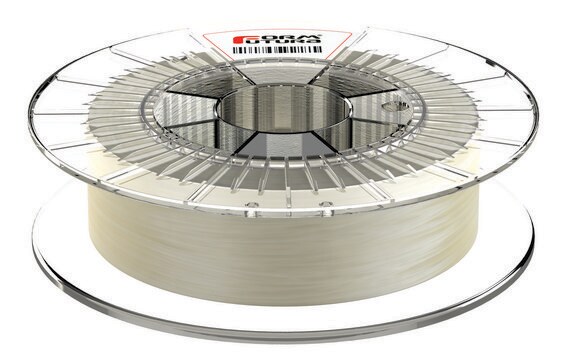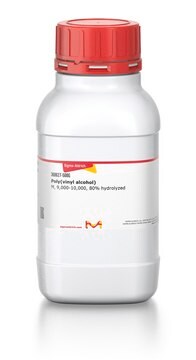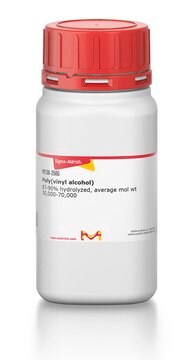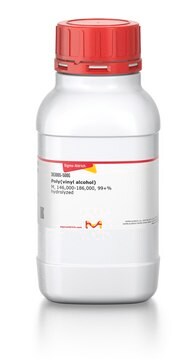추천 제품
Quality Level
설명
Filament roundness: ≥95%
Melt flow rate: 2.3 g/10 min
Melt temperature: ±163 °C
Print temperature: ±180-205 °C
Specific gravity: 1.22 g/cc
Spool Hub Diameter: 52 mm
Spool Size (DxH): 200 mmx55 mm
Vicat softening temperature: ± 60.2 °C
형태
solid (filament)
색상
orange, natural
직경
1.75 mm±0.05 mm (filament diameter)
InChI
1S/C2H4O/c1-2-3/h2-3H,1H2
InChI key
IMROMDMJAWUWLK-UHFFFAOYSA-N
유사한 제품을 찾으십니까? 방문 제품 비교 안내
일반 설명
Polyvinyl alcohol (PVA) blend printing filament is a water-soluble support material for multi-extrusion 3D printing of complex architectures. This material is a blend of different grades of PVA to improve the thermal stability and printability of polyvinyl alcohol. In addition to these improvements, this blend is also less sensitive to degradation by humidity while retaining its water solubility. This pale orange, odorless, and high-quality filament extrudes between 180 to 205 °C and is suitable with all RepRap technology-based desktop 3D printers, such as MakerBot, Ultimaker, RepRap (Mendel, Huxley, Prusa), UP, Solidoodle, Leapfrog, etc. This PVA blend filament features good adhesion to a wide variety of materials, such as PLA, ABS, PETG, ASA, HIPS, and nylon, and is biodegradable in water with no hazardous by-products. While PVA is soluble in cold water, the dissolution process can be accelerated by using a continuously heated bath of warm water. When not in use, the filament should be stored at room temperature in dry conditions, such as in a sealed plastic bag or in a closed container with desiccant. Recommended initial printer settings can be found in the ′General Print Settings′ file.
애플리케이션
AtlasSupport™ is a trademark of Formfutura VOF
Due to its water-solubility and biocompatibility, polyvinyl alcohol (PVA) filaments are most commonly used as a sacrificial material in the formation of tissue engineering constructs with unique and complicated architectures. The use of this material allows for the printing of scaffolds with large overhangs, deep internal cavities, and/or intricate geometries. In addition to their use as sacrificial materials, PVA filaments have also been used to print novel oral drug delivery devices and tablets.
법적 정보
AtlasSupport is a trademark of Formfutura VOF
Storage Class Code
11 - Combustible Solids
WGK
WGK 1
Flash Point (°F)
49.5 °F - closed cup
Flash Point (°C)
9.7 °C - closed cup
가장 최신 버전 중 하나를 선택하세요:
이미 열람한 고객
Alice Melocchi et al.
International journal of pharmaceutics, 509(1-2), 255-263 (2016-05-25)
Fused deposition modeling (FDM) is a 3D printing technique based on the deposition of successive layers of thermoplastic materials following their softening/melting. Such a technique holds huge potential for the manufacturing of pharmaceutical products and is currently under extensive investigation.
Shuai Li et al.
ACS applied materials & interfaces, 8(38), 25096-25103 (2016-09-09)
Despite considerable advances in tissue engineering over the past two decades, solutions to some crucial problems remain elusive. Vascularization is one of the most important factors that greatly influence the function of scaffolds. Many research studies have focused on the
R Hernández-Córdova et al.
Journal of biomedical materials research. Part A, 104(8), 1912-1921 (2016-03-19)
Biomaterial scaffolds are a key part of cardiac tissue engineering therapies. The group has recently synthesized a novel polycaprolactone based polyurethane-urea copolymer that showed improved mechanical properties compared with its previously published counterparts. The aim of this study was to
Tatsuaki Tagami et al.
Biological & pharmaceutical bulletin, 40(3), 357-364 (2017-03-03)
Three-dimensional (3D) printers have been applied in many fields, including engineering and the medical sciences. In the pharmaceutical field, approval of the first 3D-printed tablet by the U.S. Food and Drug Administration in 2015 has attracted interest in the manufacture
Soumyaranjan Mohanty et al.
Materials science & engineering. C, Materials for biological applications, 55, 569-578 (2015-06-29)
One of the major challenges in producing large scale engineered tissue is the lack of ability to create large highly perfused scaffolds in which cells can grow at a high cell density and viability. Here, we explore 3D printed polyvinyl
자사의 과학자팀은 생명 과학, 재료 과학, 화학 합성, 크로마토그래피, 분석 및 기타 많은 영역을 포함한 모든 과학 분야에 경험이 있습니다..
고객지원팀으로 연락바랍니다.







